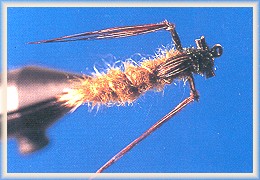Glenn developed his bug on the shores of Plateau Lake
in the Merrit-Kamloops region of British Columbia in the
spring of 1980. It is a pattern aimed at impersonating the
large climbing nymphs or darners. Fishing was slow and as
Glenn put it, "It was one of those off periods when fish
weren't biting and a cold beer and some serious fly tying
seems to be in order!' Possessing a good knowledge of
dragon nymph features and behavior, Glenn set about designing
a pattern that highlighted the large abdomen, long stout
legs and bulging eyes. Other patterns such as Jules Bloom's
Peterhope Nymph inspired Glenn. Jules ran the lodge at
Peterhope Lake during this time and Glenn had the pleasure
of watching him tie some ugly looking dragons. These ugly
dragons worked wonders on the large Peterhope fish.
Materials List:
Hook: Mustad Signature R74 or 9672, #4 - #10.
Thread: Black Monocord.
Tail and Underbody: Natural deer hair.
Body: Seal's fur.
Rib: Fine oval tinsel.
Wingcase: Pheasant tail.
Thorax: Seal's fur.
Legs: Knotted pheasant tail fibers (6).
Eyes: Pheasant tail fibers.
Head: Peacock herl.
Instructions - Butler's Bug:
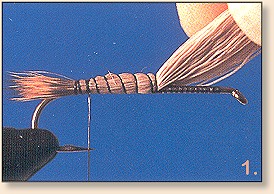
1. Cover the hook shank with thread. Prepare and
stack a pencil-sized clump of deer hair. Tie in the
deer hair at the halfway point on the hook. The tips
of the deer hair should reach back no further than the
bend of the hook.
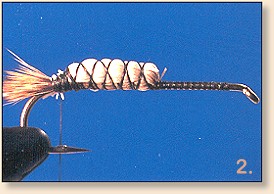
2. Pull the deer-hair butts back along the rear of
the body to provide additional bulk and floatation.
Trim the excess butt material.
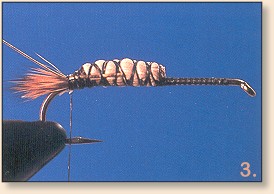
3. Tie in a rib of fine oval tinsel. Cover the underbody
with a few additional securing wraps of thread. The underbody
should not spin or rotate.
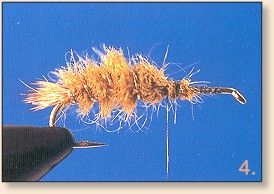
4. Using a dubbing loop form a fuzzy body. Wind the rib
over the body, tie off and trim.
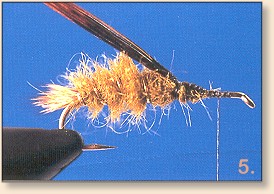
5. Tie in a clump of pheasant tail fibers by the tips
for the wingcase.
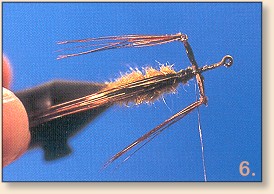
6. Take a pair of prepared knotted pheasant tail fibers
and figure-eight them in place about half way up the
thorax area.
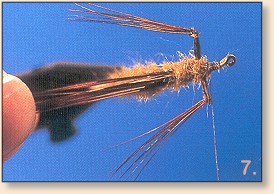
7. Dub the thorax by traveling back and forth a
couple of times to lock the legs in place.
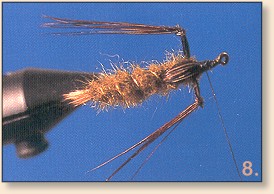
8. Pull the wingcase over the top. Tie down and trim
the excess wingcase material.
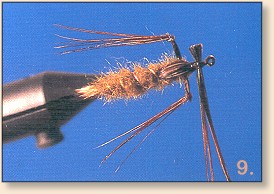
9. Remove several fibers from a pheasant tail. Bunch
them together so they are about the size of a wooden
match. Figure-eight them in place about 2 eye widths
back from the hook eye.
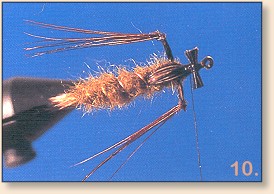
10. Trim the eyes slightly wider than the thorax.
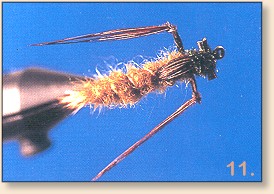
11. Tie in 3 full peacock herls. Wind the herls in
and around the eyes, forming the head. Keep the head
proportional to the size of the fly. Be careful not
to make it too big. Form a neat head and finish the
fly.
How to Fish the Butler's Bug
Glenn has a number of ways he likes to fish his bug.
If he can see cruising trout, he casts ahead using a
sink-tip line to carry the fly down. When the fish
comes into range he begins a series of quick strips.
If the trout is interested it will dart over and attack
the fly. This is an exciting way to fish. Butler's
Bug is a great pattern to fish blind too, Glenn uses a
mixed retrieve consisting a slow hand-twist retrieve
with short snappy strips. The snappy strips imitate
the jetting motion of a fleeing or hunting dragon nymph.
During the evening, Glenn switches to a dry line and
casts his bug into the shallows attracting numerous
fish. For many anglers Butler's Bug is a go-to
pattern in the absence of other clues. Bumped along
the bottom, retrieved up the slope of a deep drop-off
or trolled leisurely behind a float tube, Glenn's dragonfly
concoction seems magical. Glenn told me that during a
sedge hatch, smaller versions of his bug have also worked
admirably, another litmus test to this patterns
versatility. ~ PR
Credits: From Fly Patterns for Stillwaters,
by Philip Rowley, published by Frank Amato Publications.
We appreciate use permission.

